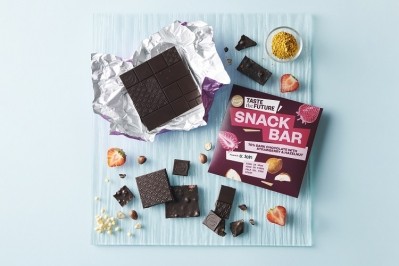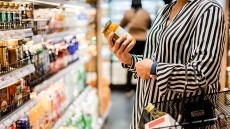How Fazer makes confectionery with upcycled ingredients

Upcycling is having a moment, and why shouldn’t it. The practice of valorising side streams to make new ingredients for industry both cuts food waste and improves product sustainability profiles.
In Finland, Fazer is testing the water with a limited-edition confectionery, made with upcycled ingredients. While on sale, the company is asking for consumer feedback to help make improvements where necessary.
Fazer taps ‘okara’ from oat drink production
The Oat Choco toffee hearts, sold under Fazer’s Taste the Future line, are made with two upcycled components: one a side stream of oat milk production, and the other from confectionery production.
The chocolate hearts are filled with ‘okara’ toffee. Traditionally okara refers to a side stream from soymilk production, but Fazer is using the term to describe its oat drink counterpart.
To make oat drink, manufacturers use wholegrain oats, removing the inedible outermost part of the grain known as the husk. Oat okara is made from insoluble parts of the oat grain, making it rich in protein and fibre. If not upcycled, oat okara usually goes into biogas production or animal feed.

In Fazer’s Oat Choco toffee hearts, 0.7% of the toffee is made from oat okara. As to what function the ingredients serves in confectionery production, the okara brings ‘fullness’ to the taste, which is traditionally obtained from milk, a Fazer spokesperson told this publication.
The company is currently sourcing the oat okara from an external supplier, but told us it plans to use multiple sources from several productions in Northern Europe in the future.
Upcycling surplus from confectionery production
The other upcycled input in Fazer’s Oat Choco toffee hearts is sourced from its own confectionery production; the ‘oat choco’ component is made from broken or underweight Karl Fazer Oat Choco tablets.
Indeed, more than half of the raw materials in the new confections are derived from Fazer’s confectionery production side stream, with the intention of reducing food processing waste.
“In food production, it is impossible to eliminate process loss completely, but raw materials should be reused as efficiently as possible – as Fazer confectionery has been doing for decades,” said Annika Porr, senior manager at Fazer Confectionery’s Forward Lab.
The move aligns with Fazer’s commitment to reduce its avoidable food loss by 50% by 2030 – from a 2020 baseline. It also aligns with the European Parliament’s proposal to set legally binding targets to reduce food waste across the bloc, including 20% in processing and manufacturing by 2030.
“Fazer’s commitment to sustainability is a key catalyst for our creative R&D advancements. The choco hearts may sound like a classic but the ingredients we use are new into the game. Not only are the ingredients new, but we have had a talented production team with a real interest and motivation in developing delicious and sustainable plant-based innovations,” said Porr.
Do consumers know what ‘upcycled food’ means?

The new product is also designed to meet consumer demand for sustainable lifestyles, and Fazer is alerting consumers to the product’s upcycled content via an ‘upcycled label’.
As to whether consumers truly understand the concept of upcycled food, however, is not certain. Recent research suggests consumer understanding is low, with just 10% in the UK, 15% in New Zealand and 35% in Türkiye, understanding the concept.
In Italy, awareness appears to be higher – at 61% - with another 20% aware of the term ‘upcycled food’ but not the concept.
The term ‘upcycling’ is modern and international, the spokesperson told us, admitting it may not be instantly understandable to consumers. “Therefore, the term would benefit from adding a clarifying tagline, such as ‘contains rescued ingredients from food production’.
“Many consumers consider upcycling as an innovative and positive concept and assume that food companies take their responsibility to reduce and utilise waste. However, a lot of communication and education is needed to increase consumer awareness and understanding about upcycling.”






















